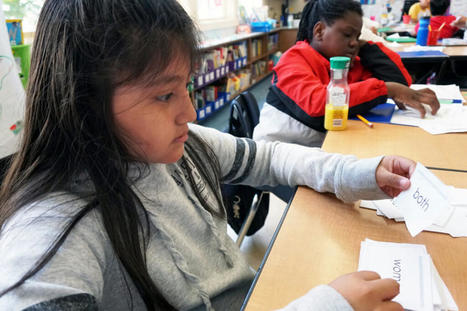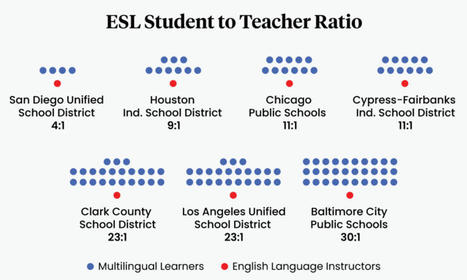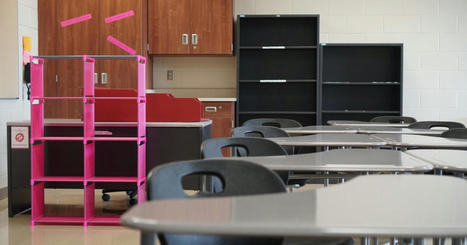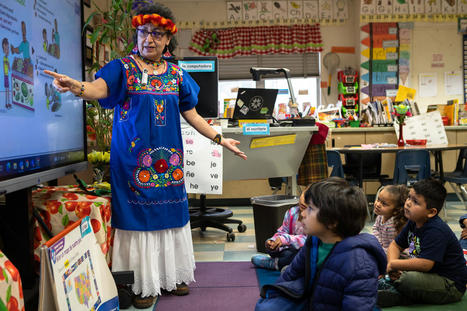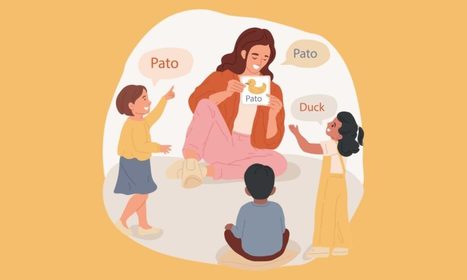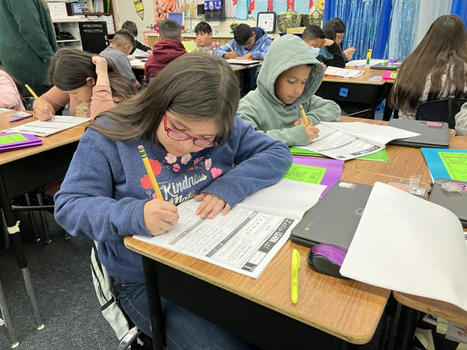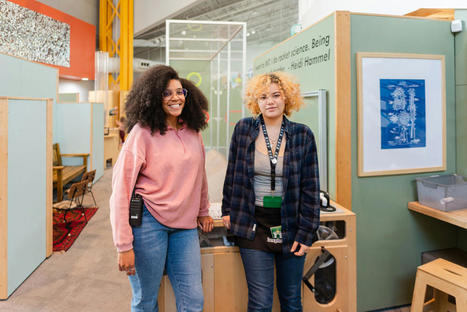 Your new post is loading...
Whenever we hear an educator begin a statement with the words “Research says...,” we must attend with caution. This is because what is said is an interpretation or a translation of research. The interpretation may or may not accurately reflect the findings of specific research studies. In this article, I express concerns about what is lost in translation in the interpretation of what the science of reading (SoR) research says about particular approaches to and strategies for reading and writing instruction from my positionality as a bilingual teacher educator and researcher in dual language education. In the February 2023 edition
New research from the University of East Anglia (UEA), UK has found evidence that talking to toddlers helps to shape their developing brain. A team from the School of Psychology at UEA led by Professor John Spencer, captured thousands of hours of language data from babies and toddlers who were equipped with small recording devices. MRI scans were also carried out to explore the structure of the participants’ developing brains, focusing on a substance called myelin. Lead researcher Prof John Spencer explained “Myelin is made up of protein and fatty substances and forms an insulating layer around nerves in the
For at least a half-century, there has been a great deal of discussion about how children learn to read. While policymakers, curriculum developers, educational leaders, and those in the media have been using this discussion to drive headlines and policy, reading scientists across the world have been formulating questions and conducting experiments to find answers to specific questions regarding how the human brain learns to read. We are far from knowing all the answers, but the research does provide many important concrete understandings about how our brains acquire the complex process of turning marks on a page into language, as
The research shows that both native English speakers and bilingual students who are learning English must learn how to connect the oral sounds in words to the letters that represent those sounds, then connect that connection to the words' meanings. But, English learners need additional support.
Tom Horne says dual language programs violate Arizona law if they include students not yet proficient in English, which they do. How Arizona got here.
Scientists in Leipzig, Germany have found evidence that the language we speak affects the connectivity pathways in our brain, potentially framing the way we think. A research team from the Max Planck Institute for Human Cognitive and Brain Sciences used magnetic resonance tomography (also known as magnetic resonance imaging/MRI) to study the brains of native German and Arabic speakers, finding differences in the neurological wiring of language areas in each group. Doctoral researcher Xuehu Wei compared the brain scans of 94 native German and Arabic speakers, choosing the two languages based on their extreme differences. The MRI scan results conclusively
Teacher staffing levels for English learners swing widely across the country and shortages abound, but appropriate class size can hinge on many things
How did you spend much of 2020? Hours online? And then came 2021, being both easier and more challenging than we could have ever imagined. Many within and outside the education world agree that the pandemic was a catalyst for change for multiple reasons. It was no longer about how we use technology to provide access to daily lessons or to enhance content and language instruction for our students. Our focus has shifted from how to use technology to support multilingual learners to how to use technology to create digital-age learning ecosystems for them. Designing complex learning ecologies to advance
It has been hypothesized that successful bilingual education rests on three pillars (Krashen, 1996): Pillar 1: Helping children learn to read in their first language. It is easier to learn to read in a language you understand, and this competence facilitates learning to read in the second language. For example, Dow, Krashen, and Tinajero (2009, 2010) reported that better reading in the first language (Spanish) in second grade was clearly related (r=.52) to better reading in the second language (English) in sixth grade. In other words, literacy transfers. One reason for this is that reading results in knowledge, and the
Illinois ranked highly in a nationwide teacher diversity analysis. But in many schools, teachers still don't reflect student diversity.
EAST BRUNSWICK, NJ - "The English as a Second Language (ESL) Program in East Brunswick Public Schools serves students who are multilingual and require language instruction to become proficien

|
Scooped by
Dual Language Education of New Mexico
February 26, 2023 12:24 PM
|
While students delight in writing essays using artificial intelligence tools such as ChatGPT, hoping to save time and effort, experts in linguistic

|
Scooped by
Dual Language Education of New Mexico
February 23, 2023 1:40 PM
|
An explanation of how universal design for learning can improve teaching for multilingual international students and domestic students alike
|
Even behind masks or through a screen, the language that educators use is one of the most powerful tools available to build a relationship with students, support their identities, and scaffold their learning. Like our breath, our teacher language is always with us and has a significant effect on how we self-regulate and exchange energy with our classes. That might sound lofty or ethereal, but it’s fundamentally true. Most of us rarely think about our breath, but science and experience tell us that when we control our breath, we can better manage our emotions, health, and relationships (Walter et al.,
Babies who cannot speak may still benefit from a second language. Some education experts say children who learn more than… Continue reading The Bilingual Hidden Superpower: Bilingual Infants Think and Learn Differently
In a recent study published in the journal Science Advances, French researchers examined how bilingual people neurologically process their respective languages in written form. The study carried out by a team of clinical neurologists, neuropsychologists and researchers, and funded by the Agence Nationale de la Recherche, found that a part of the brain called the Visual Word Form Area (VWFA) behaves differently for English-Chinese speakers compared to English-French speakers. It has also shed light on specific research towards different forms of bilingualism, with most accredited research comparing monolingualism and bilingualism. There is much scientific evidence to credit bilingualism beyond its
English learners are underrepresented in dual-language programs as California struggles to meet its goal of having majority bilingual students by 2030.
NWEA, a not-for-profit research and educational services organization serving K–12 students, has released a new study focusing on the identification of gifted and talented (GT) students who are English learners (ELs) and/or students with disabilities (SWD). Using data from the 2017–2018 Civil Rights Data Collection, the Stanford Education Data Archive, and the researchers’ own coding of individual states’ policies toward gifted and talented education, these key themes emerged: • The study confirms that ELs and SWD are identified at rates that are one eighth to one sixth of their representation in the overall student population. • State mandates for schools
When someone hears a concept or a person’s name for the first time, the most common way of learning this new word is to repeat it out loud. However, previous studies have found contradictory effects of this almost-simultaneous production on our capacity to learn new words. A new study, carried out by Spain’s Basque Center on Cognition, Brain, and Language (BCBL), found that when learning new vocabulary repeating the words can have negative effects on learning, particularly when the repetition is immediate. Silently listening to the word or pausing between hearing and producing the word can be more effective ways
Studies consistently demonstrate exposure to an additional language, including a minority language, does not impact language outcomes negatively
Tim Shanahan chaired the National Literacy Panel for Language Minority Children and Youth and co-edited the resulting 2006 report.
Kathleen Leos directed the Office of English Language Acquisition in the U.S. Department of Education when George W. Bush was president.
By Tim Hand | Ocotillo Strategies, former Deputy Secretary of Education With the abundant financial resources the state has garnered, New Mexico is ripe for transformation of the high school experience. Let's go big. The time is now.

|
Scooped by
Dual Language Education of New Mexico
February 28, 2023 4:16 PM
|
Literacy is essential for success in school and in life beyond school. The ability to read and write well provides individuals with untold opportunities as they move through school, pursue advanced education and careers, and achieve their goals. Strong literacy competencies contribute to social and economic equity for individuals in underrepresented communities. Multilingual learners in the US, those students who are not yet proficient in English, must learn this new language to advance through school. While these students possess the gift of their home languages, these are not typically the language of instruction at school. Thus, multilingual students are learning

|
Scooped by
Dual Language Education of New Mexico
February 24, 2023 1:23 PM
|
Carola Suárez-Orozco discusses the social-emotional needs of immigrant students
|




 Your new post is loading...
Your new post is loading...



